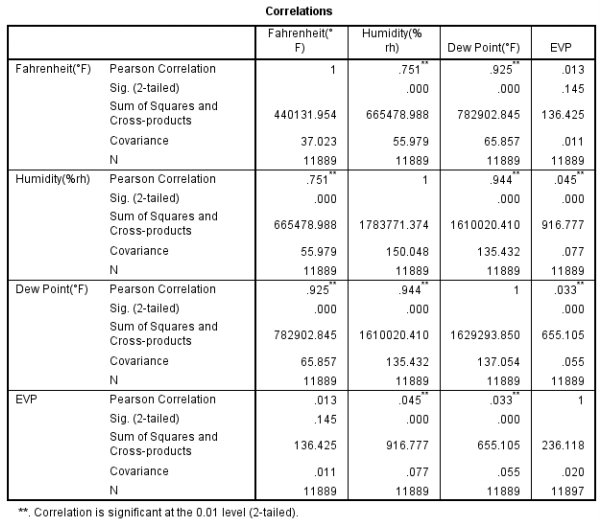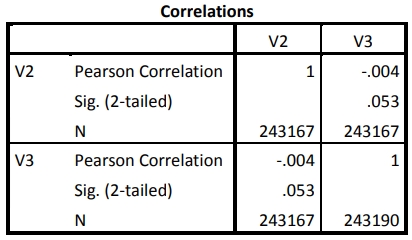By Jack Trammell, Ph.D.
Center for Paranormal Research and Investigation
March 22, 2016
Abstract
Using a large combined data set from multiple investigations that includes regularly logged measures of environmental information, and a strict criterion-based definition for perceived EVPs (electronic voice phenomenon), basic statistical analysis was conducted to identify statistically significant correlations. The results indicate that some environmental factors, such as humidity and electromagnetic field fluctuation, appear to be more closely related to perceived EVPs than others. This paper will also include a guided discussion of the criterion-based EVP definition, and the need for more in-depth instrumentation and analysis in future research.
Introduction
Perceived EVPs (electronic voice phenomena) are often purportedly accompanied by environmental changes which can be measured scientifically. Such perceived auditory events have been recorded on various devices since the invention of recording technology. The research hypothesis in this study postulated that in a large enough data pool, correlations between EVPs and environmental variables could be substantiated and quantified by statistical analysis.
The anthropology of ghosts and ghost lore presents the modern researcher with thousands of anecdotal accounts of disembodied voices and other mysterious sounds reportedly witnessed by people over the course of many centuries of human recorded history. In the modern era, accounts of mysterious voices and sounds appearing on recording equipment, and otherwise unaccounted for, have perpetuated the popular tradition, and added to it the term “EVP” as a label for a recorded voice or sound that otherwise cannot be explained environmentally.
The popularity of television shows, web sites, and clubs themed around the paranormal has resulted in an explosion of supposedly captured EVPs that are possibly paranormal in nature. Less commonly, researchers following the scientific method have attempted to aggregate data and examine patterns in what are reportedly EVPs, to determine what if any configurations and patterns can be discerned. One popular theory, for example, maintains that paranormal events are accompanied by a drop in temperature in the immediate vicinity. Another maintains that electromagnetic flux can be associated by an auditory event.
None-the-less, almost no serious research has been done to determine if there is a pattern in how perceived EVPs occur and are empirically captured (let alone a larger effort to determine what, if anything, they are, which is well beyond the scope of this article).
Method
CPRI (The Center for Paranormal Research and Investigation) is one of the longest established paranormal research organizations in the mid-Atlantic region, and has from its founding been committed to scientific methods and strict standards for research rigor. As a result, the data they have collected is significant in terms of volume and viability (there were over a million data cells in the file used for this study).
This study specifically collected longitudinal data from more than two dozen separate investigations and used the follow definitions to create a Meta data set:
- Electronic Voice Phenomenon (EVP) is defined in this study strictly as “perceived” meaning that this analysis makes no attempt to prove or disprove the actual existence of EVPs. In order to control for what a perceived EVP consisted of, the following guidelines were used as outlined below.
- Perceived EVPs found on recorders or audio from videos were subjected to wave form analysis to debunk the possibility of physical human voices or other natural sounds in the environment.
- Whenever possible, triangulation of data points was employed, confirming a perceived EVP in multiple instrument readings.
- All perceived EVPs were compared to past history in an EVP data bank to confirm the general characteristics that have been measured over time (wave length, duration, intensity, etc.)
Once the EVP data was entered (n = 251), environmental data from loggers which were set up at the scene, generally within a ten foot radius of the device collecting the EVP, provided real-time data for the entire length of each investigation on: temperature, humidity, dew point, and tri-axis electromagnetic flux. Statistical tests were run to identify possible correlations.
Results
Perceived EVP occurrence was strongly correlated to changes in humidity and dew point, but NOT to temperature in the cases considered (see Table 1 below). While this perhaps partially “debunked” one popular notion that paranormal events are accompanied by a drop in temperature, it confirmed another that perceived paranormal events like EVPs can be more likely when water and/or humidity is present in greater amounts.
The statistical correlations for this are summarized here in Table 1:

When testing for relationship with electromagnetic flux, a significant relationship was also found at p = .05 level, although the correlation was negative, meaning that perceived EVPs were often accompanied by a drop in magnetic flux, rather than a spike as might be popularly suggested. The correlations for EMF are provided as follows in Table 2:

Discussion
There are many limiting factors in such a study, not the least of which are the subjective confounds associated with defining what an EVP actually is. None-the-less, this evidence clearly shows statistically significant relationships between what people perceive to be paranormal events, and changes in the environment that can be empirically measured. This in itself is an important finding which suggests that a great deal of further research needs to be done. In addition, since the EVPs were all saved as data files themselves, additional investigation can be done as instrumentation improves and theories evolve.
References
Banks, Joe “Rorschach Audio: Ghost Voices and Perceptual Creativity”, Leonardo Music Journal 11, pp. 77-83, The MIT Press, 2001
Raudive, Konstantin (1971). Breakthrough: An Amazing Experiment in Electronic Communication With the Dead (Original title: The Inaudible Becomes Audible). Taplinger Publishing Co. ISBN 0-8008-0965-3.
Nees, Michael A.; Phillips, Charlotte (2014). “Auditory Pareidolia: Effects of Contextual Priming on Perceptions of Purportedly Paranormal and Ambiguous Auditory Stimuli”. Applied Cognitive Psychology: n/a. doi:10.1002/acp.3068. Retrieved 10 October 2014.
Appendix: Time of day for EVPs (reflecting some degree of convenience sampling; 2400 = midnight)
